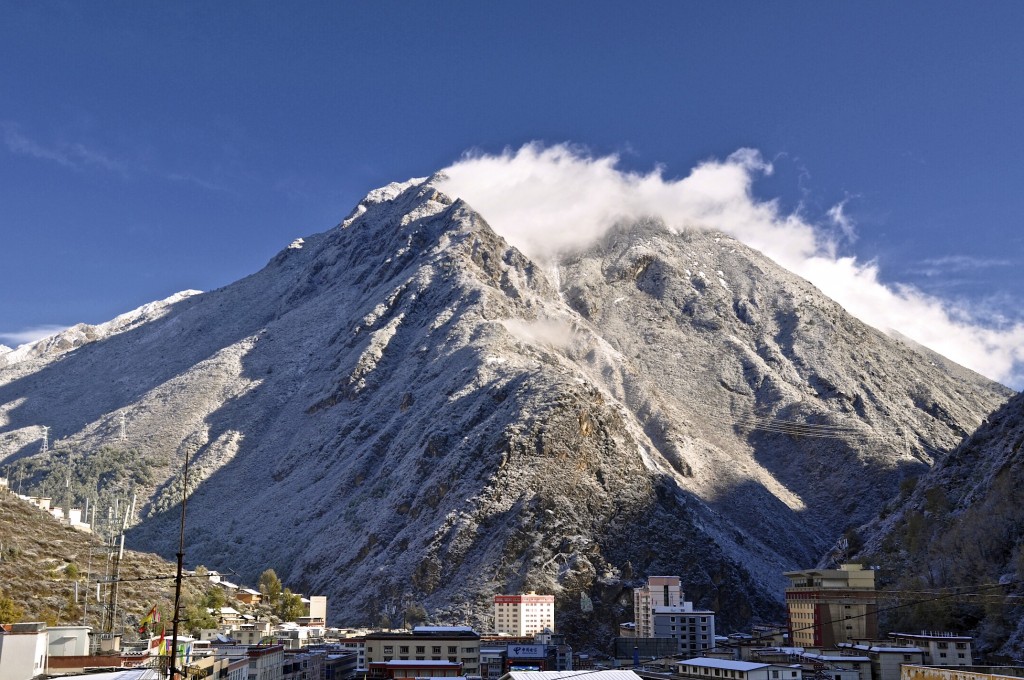
The 850 kilometer overland journey from Kangding (Dartsedo) to Yushu (Jyekundo) is one of my favorite routes to travel in the Kham region of eastern Tibet. The landscape along the way has just about everything you could ask for: grasslands, snow-capped peaks, alpine forests, lakes, rivers and also has some of the best preserved Tibetan culture. The area is full of Tibetan monasteries and, for the most part, sees relatively few travelers. Getting to Kangding from Chengdu is very easy. In addition to 1 or 2 daily flights, there are around a dozen buses per day that make the 325 kilometer trip. Here is the route I suggest taking from Kangding to Yushu with a couple of attractions off of the main route that I recommend.
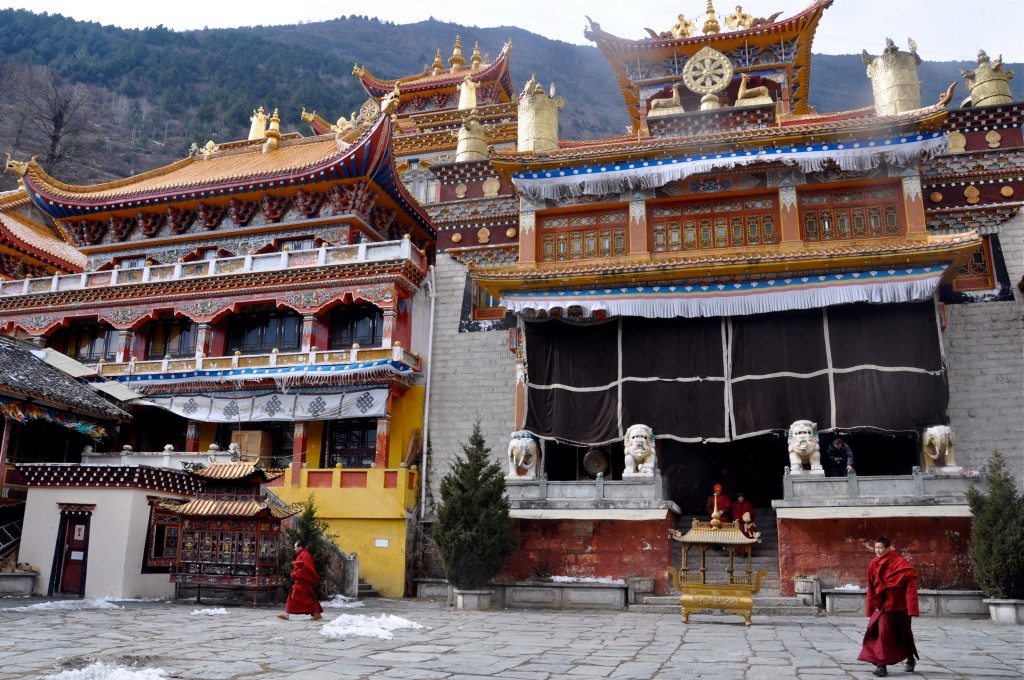
Monastery in Kangding
Day 1: Arrive in Kangding (Dartsedo) Elevation: 2500 meters
Kangding is a great place to spend 2 or 3 days. I lived here for a year and had an amazing time! This small city is the capital of Garze Tibet Autonomous Region and is fairly modern and clean. I recommend staying at Zhilam Hostel. The hostel is located in a small village just above Kangding. It offers clean dorm rooms, great food and the hostel can give you all kinds of excellent travel advice.
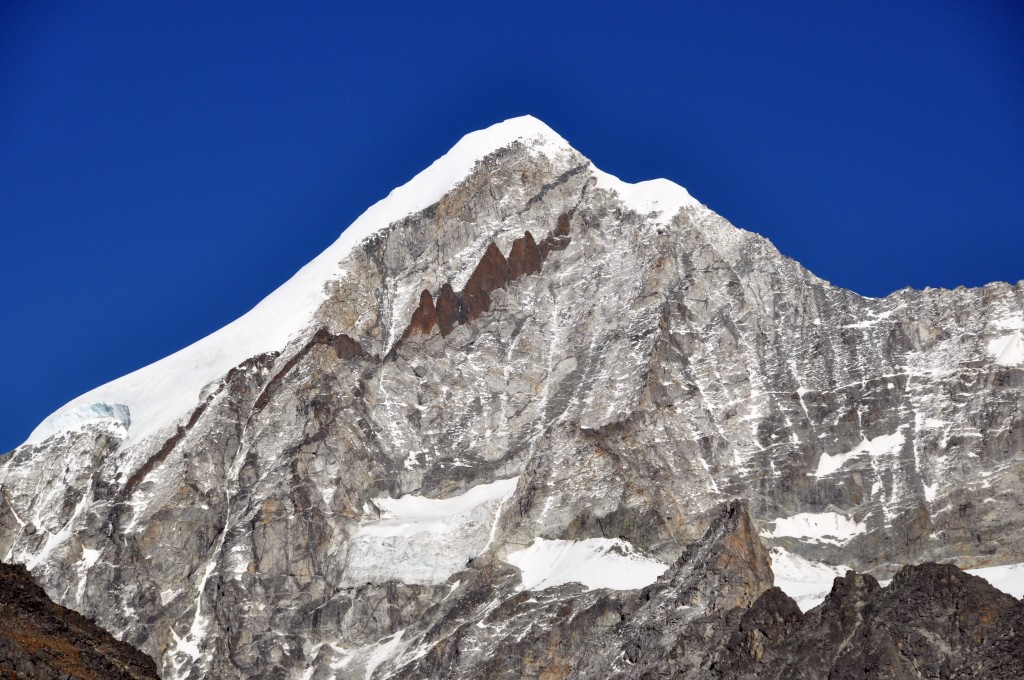
Mt. Lhamo She rising over 6000 meters. You can get a good view of this peak from the Yajiagen Pass, which is just 30 kilometers from Kangding.
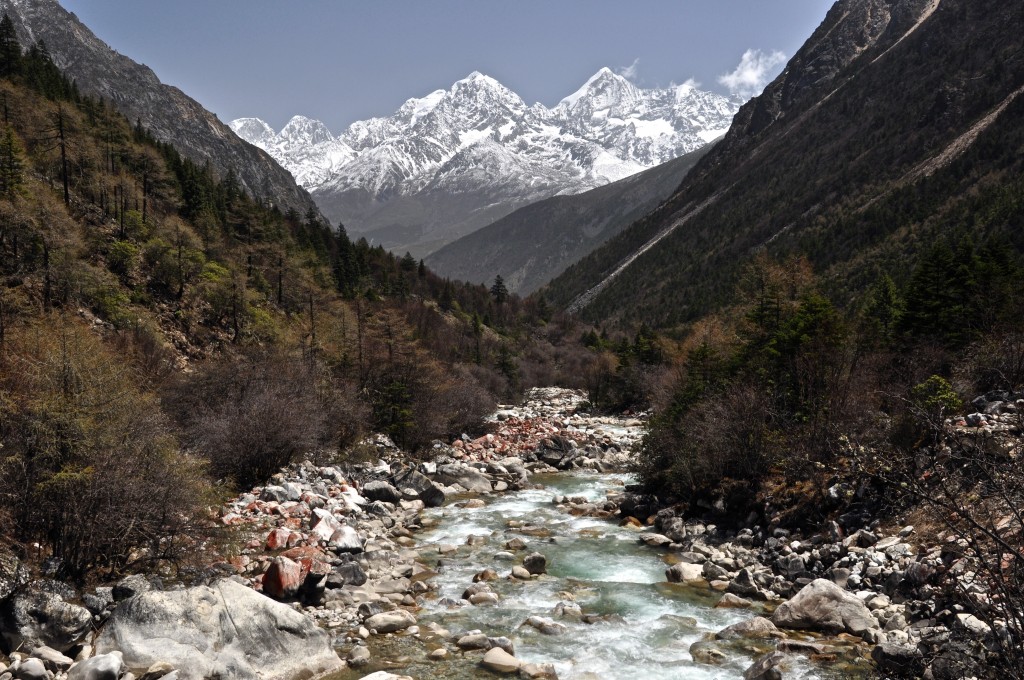
View of the snow-capped peaks near Kangding from the Minya Konka trek.
Day 2: Kangding
Kangding has 3 Tibetan Buddhist monasteries in town to explore. There is also a couple of good day hikes in town to take. The first is to simply hike up to the grasslands that lie high above Zhilam Hostel. Ask Kris at the hostel to show you where the path starts. Another good day hike is to go to the top of Gouda Peak, the main mountain that sits right in town. One of my favorite places to go near Kangding is the Yajiageng Pass, which is about 30 kilometers south of town. On a clear day, you get an amazing view of several glaciated 6000 meter peaks. You can hire a taxi to take you out here. Once you get here, there are also great day hikes available. You can also spend a couple of hours exploring downtown Kangding. There are several cool markets to explore. Be sure to get a great cup of coffee at the Himalayan Coffee shop and go Tibetan dancing at the large square in the center of town. Dancing starts each night shortly before sunset.
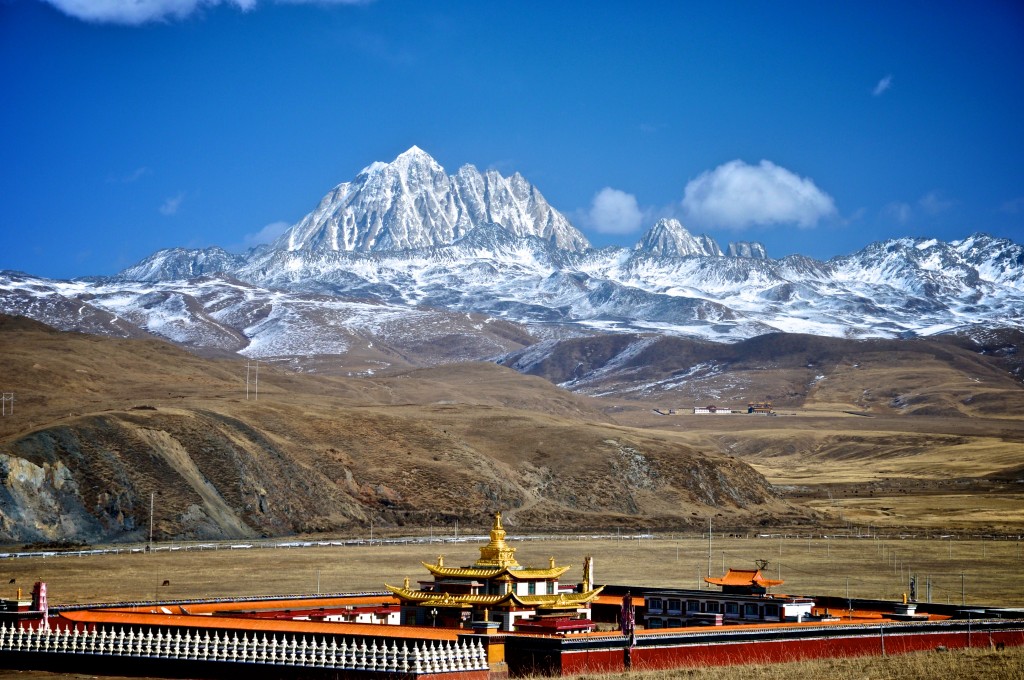
A monastery on the grasslands near Tagong (Lhagang) with Mt. Zhara Lhatse rising over 5800 meters in the background.
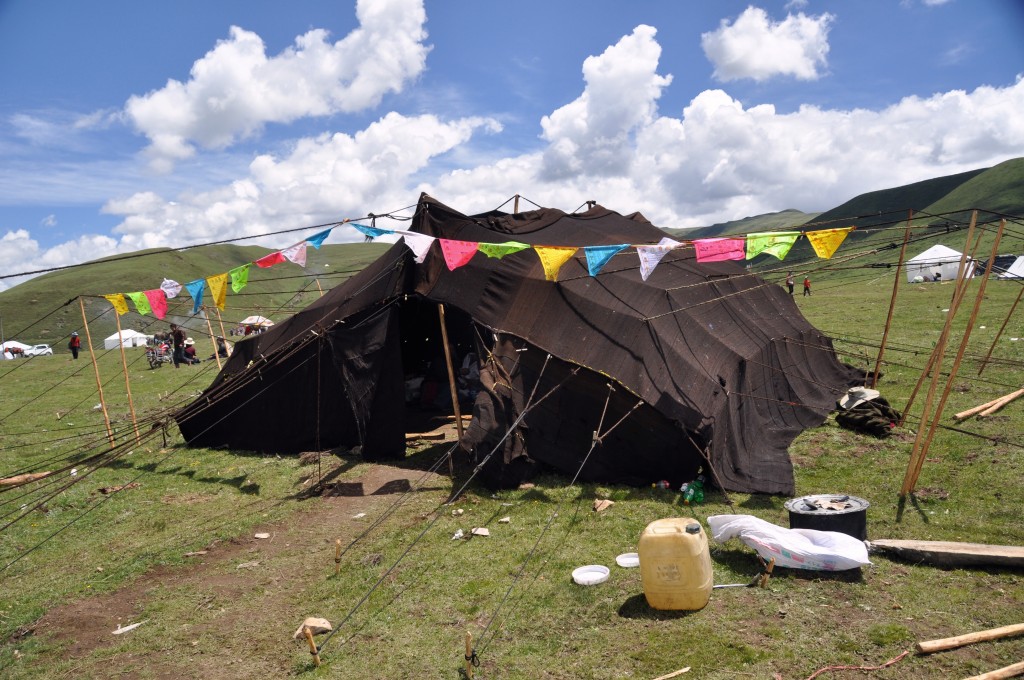
A traditional nomad tent made from yak wool on the grasslands surrounding Tagong
Day 3: Kangding to Tagong (Lhagang) Distance: 92 kilometers Elevation: 3730 meters
Tagong, known in Tibetan as Lhagang, is a really fun place to spend a couple of nights in. Tagong is a small nomad Tibetan trading post sitting at 3730 meters on the grasslands just north of the Kangding Airport. You can get to Tagong from Kangding by taking a shared mini-van taxi. Ask the front desk at Zhilam Hostel where you can catch the mini-van at. Kham Tibetan nomads can be found in town, often on horseback. The ancient Lhagang Monastery is located right in town and is an excellent place to spend a few hours exploring. Across the grasslands from Tagong is the beautiful snow-capped peak of Zhara Lhatse (Mt. Yala in Chinese), which rises to over 5800 meters. This mountain offers excellent trekking and horse trekking. Contact my friend Angela at Chyoger Treks for more information about trekking in this amazing area.
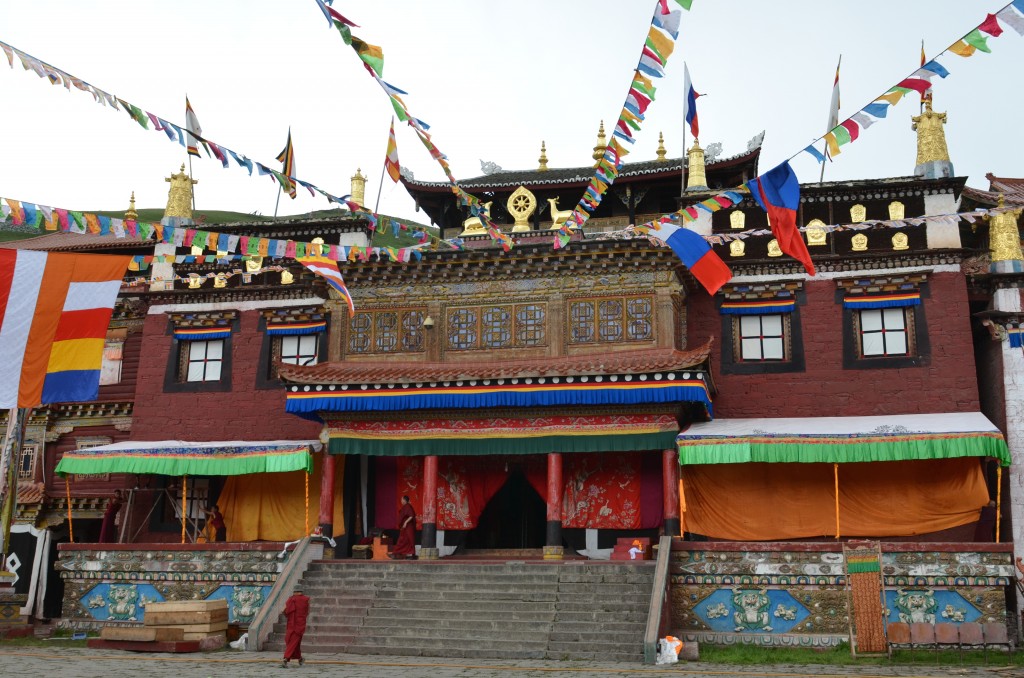
Lhagang Monastery, located right in the center of town.
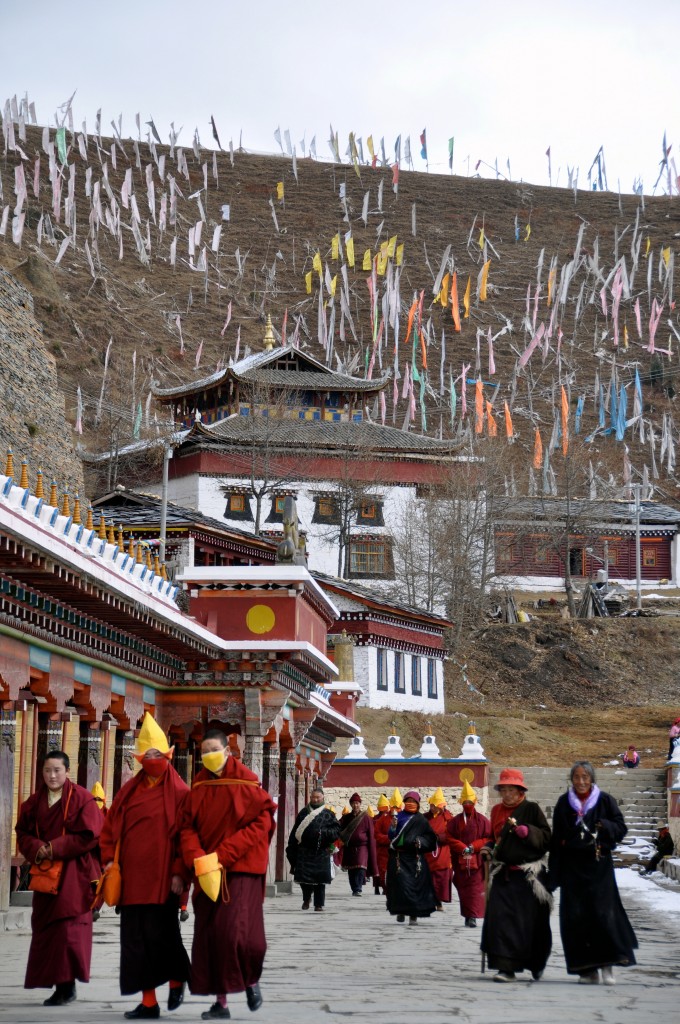
Tibetan Buddhist nunnery just outside of Lhagang
Day 4: Tagong (Lhagang)
This day, you can stroll the main street in town watching all of the wild-haired Tibetan nomads and do a bit of shopping. Just outside of town, there is a fascinating Tibetan Buddhist nunnery that is well worth spending a few hours at. In Tagong, I often stay at Gayla and Jya Drolma’s Guesthouse, which is located just across the square from the Lhagang Monastery. It is clean and basic, but very pleasant. For homestays in the region, contact Angela at Chyoger Treks.
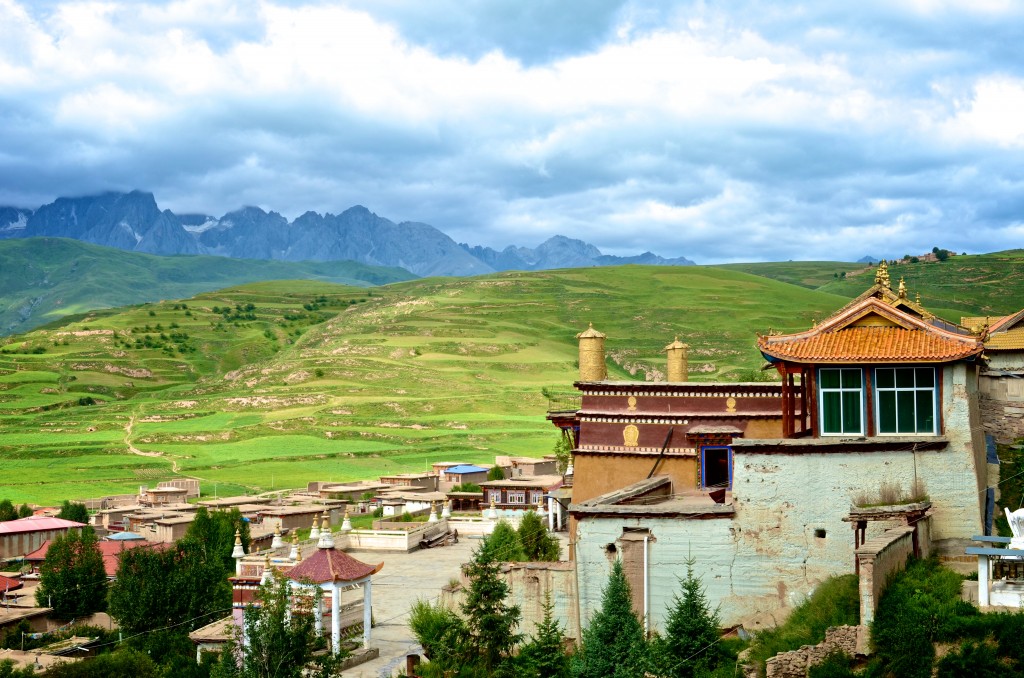
The 500 year old Garze Monastery overlooks the amazing mountains in Ganzi (Garze)
Day 5: Tagong to Ganzi (Garze) Distance: 275 kilometers Elevation: 3380 meters
The drive from Tagong to Ganzi (Garze) is quite nice. This stretch of road used to be really terrible, however, most of the road now is quite good. Ganzi is one of my favorite mid-sized Tibetan towns. It lies on the grasslands with amazing snow-capped peaks nearby. The town is full of traditional Tibetan culture. It has several good hotel options, including the Hotel Himalaya, located near the center of town. Garze Monastery is over 500 years old and offers a great view of the town below and the mountains in the distance. There is no bus originating from Tagong going to Ganzi. The bus from Kangding to Ganzi passes through Tagong. You will need to wait out on the road for the bus to come. Pay the bus fare directly to the driver. There also occasionally are shared mini-van taxi’s that go from Tagong to Ganzi. These taxi’s will leave when full.
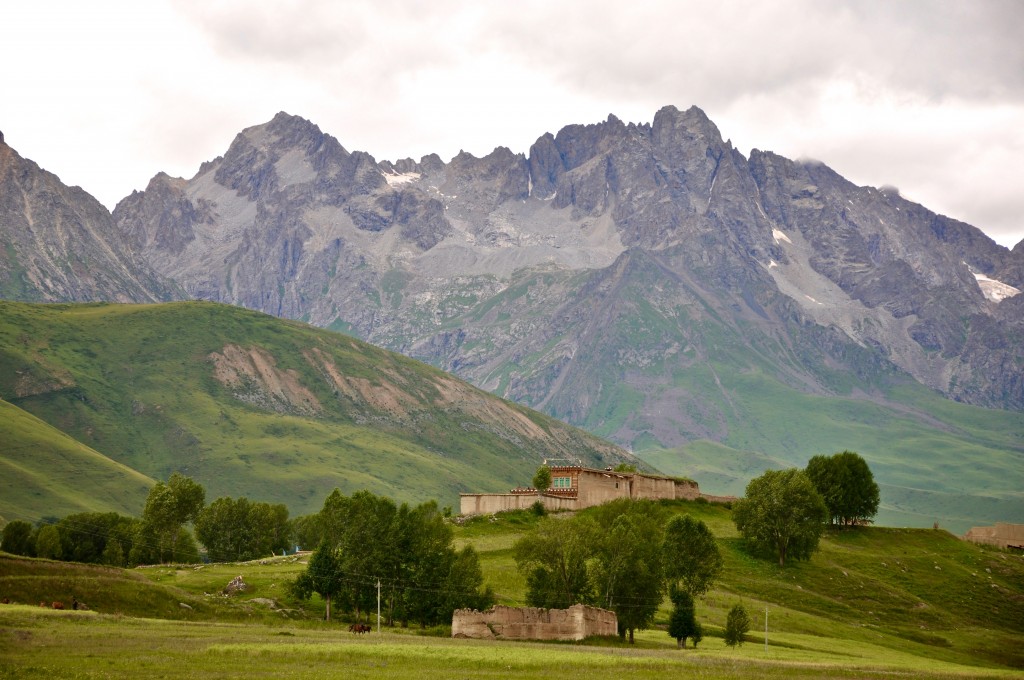
A small village along the way to Darjay Monastery just west of Ganzi (Garze) town.
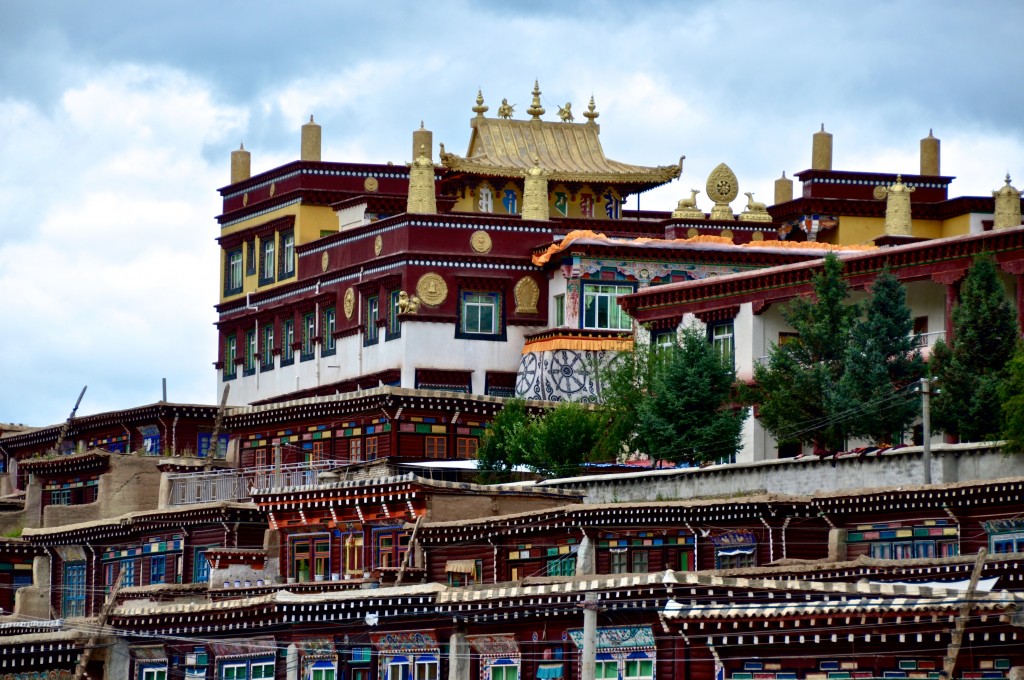
Darjay Monastery is a great place to take a day trip to from Ganzi.
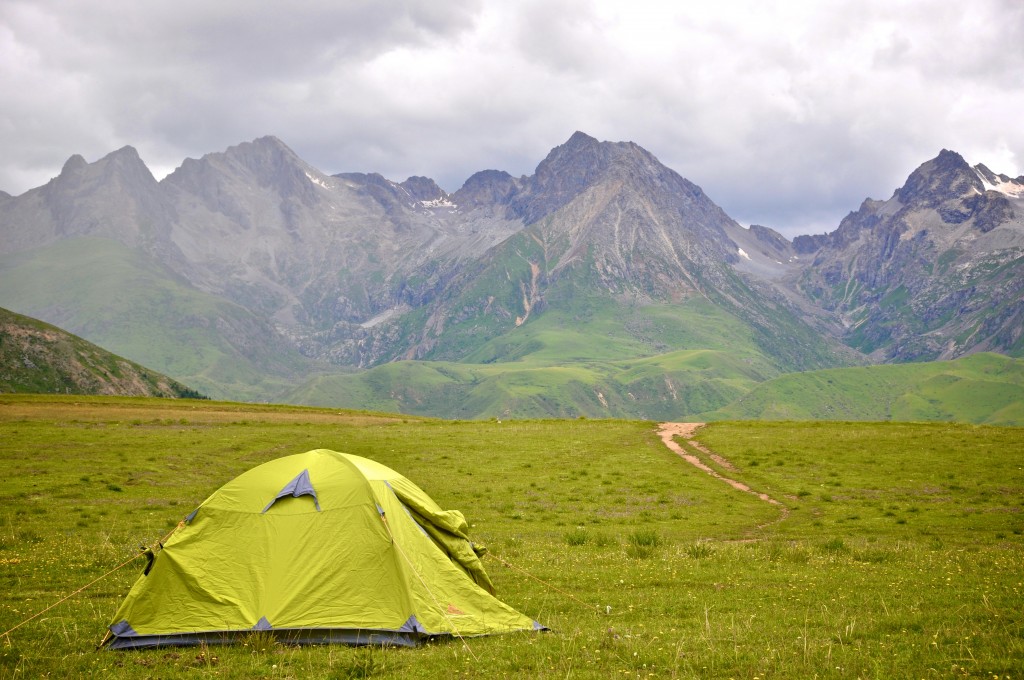
The grasslands surrounding Darjay Monastery offer some excellent places to go camping. This was my campsite during the summer of 2013.
Day 6: Ganzi
If you have extra time, I suggest taking a day trip 30 kilometers west to Darjay Monastery. This monastery is very traditional and overlooks grasslands and some amazing mountains. The monastery has a small and clean guesthouse where you can stay. Another option is to camp on the grasslands outside of the monastery. There are several small villages and monasteries in the distance that you can hike out to. You can hire a taxi from Ganzi to go out to Darjay Monastery.
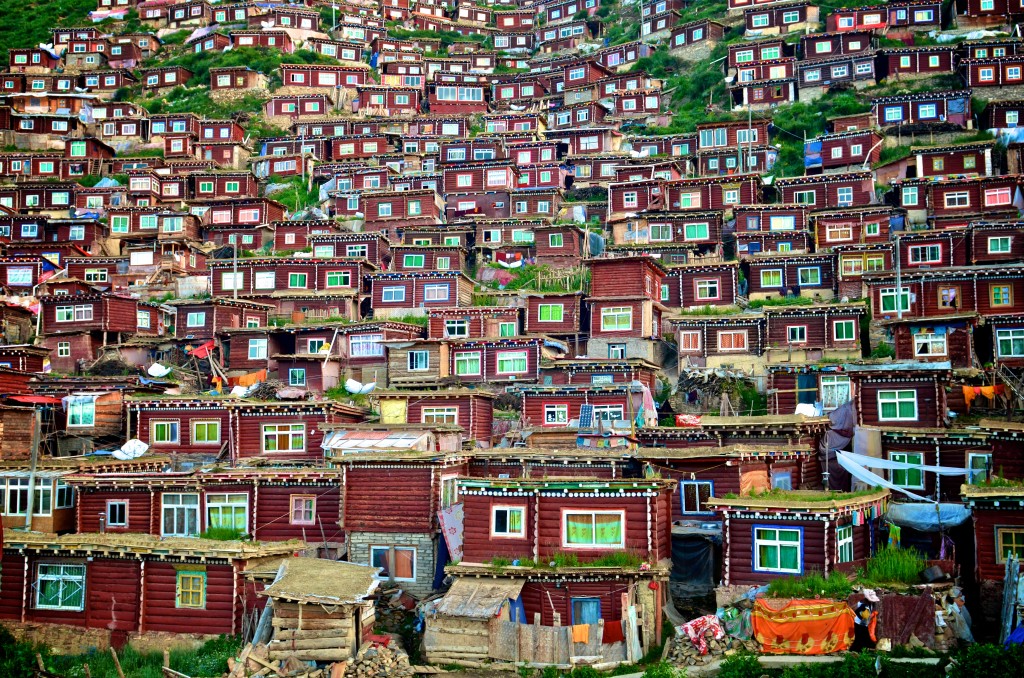
Some of the thousands of monk homes at the Larung Gar Buddhist Institute near Sertar
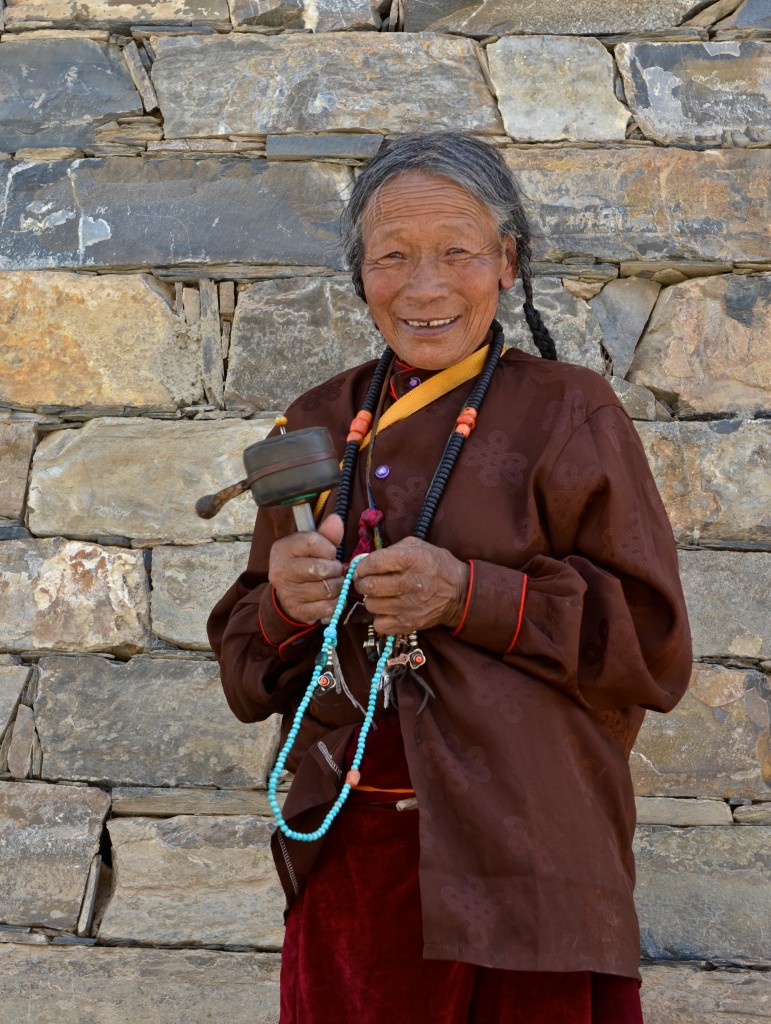
A Tibetan woman near Larung Gar in Sertar County
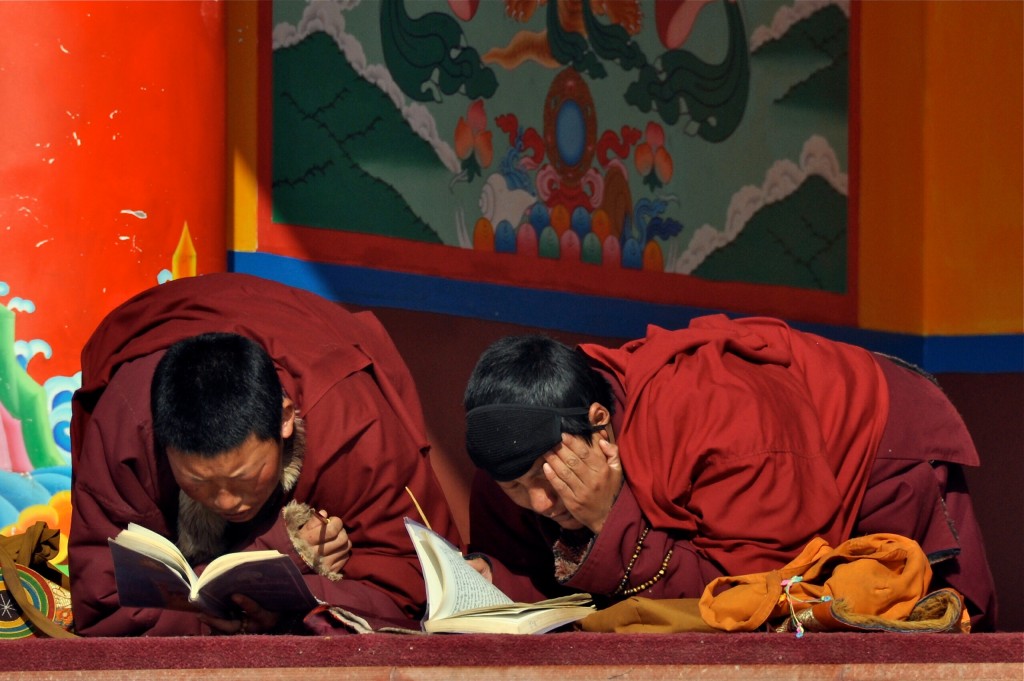
Tibetan Buddhist nuns studying at Larung Gar
Day 7: Ganzi to Sertar Distance: 150 kilometers Elevation: 3890 meters
The 150 kilometer detour to Sertar off of the main road connecting Kangding to Yushu is well worth it. The dirt road is very rough and takes around 6 or 7 hours to travel. There is normally a public bus that travels the route between Ganzi and Sertar. In addition, there should also be shared mini-van taxi’s that also cover this route. The town of Sertar is rather uninteresting, but the Larung Gar Buddhist Institute definitely is. Sertar town has a couple of decent hotel options in the center of town. In previous years, particularly in 2009 and 2010, Sertar was closed to foreign travelers from time to time. However, the past few years most foreigner travelers have had no problems being in the area. Because of the long drive from Ganzi to Sertar, I recommend spending 2 nights in order to have enough time to explore Larung Gar.
Day 8: Sertar and Larung Gar Buddhist Institute
Larung Gar is located about 25 kilometers south of Sertar town. There is one hotel located in Larung Gar, however it is usually reserved. There are several decent hotel options in Sertar to choose from. From Sertar, you can take a taxi or shared mini-van taxi to Larung Gar very easily.
Larung Gar is one of those places in eastern Tibet that is really hard to explain….you just need to see it for yourself! It is the largest Tibetan Buddhist Institute on the Tibetan Plateau and is home to over 40,000 monks and nuns. The monks and nuns live in small wooden homes that sprawl across the mountainsides surrounding the main temples. Larung Gar attracts Tibetan pilgrims from across the Amdo and Kham regions and even as far away as Lhasa. The region is quite extraordinary. I highly recommend making the detour off of the main road to Yushu to explore this area.
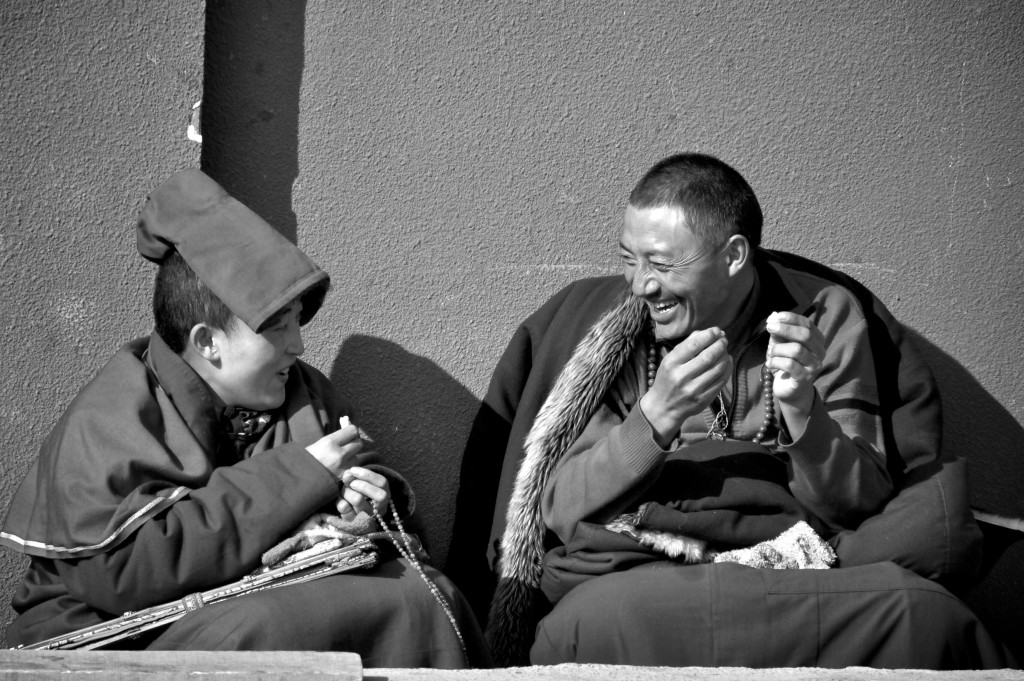
A nun and a monk chatting at Larung Gar
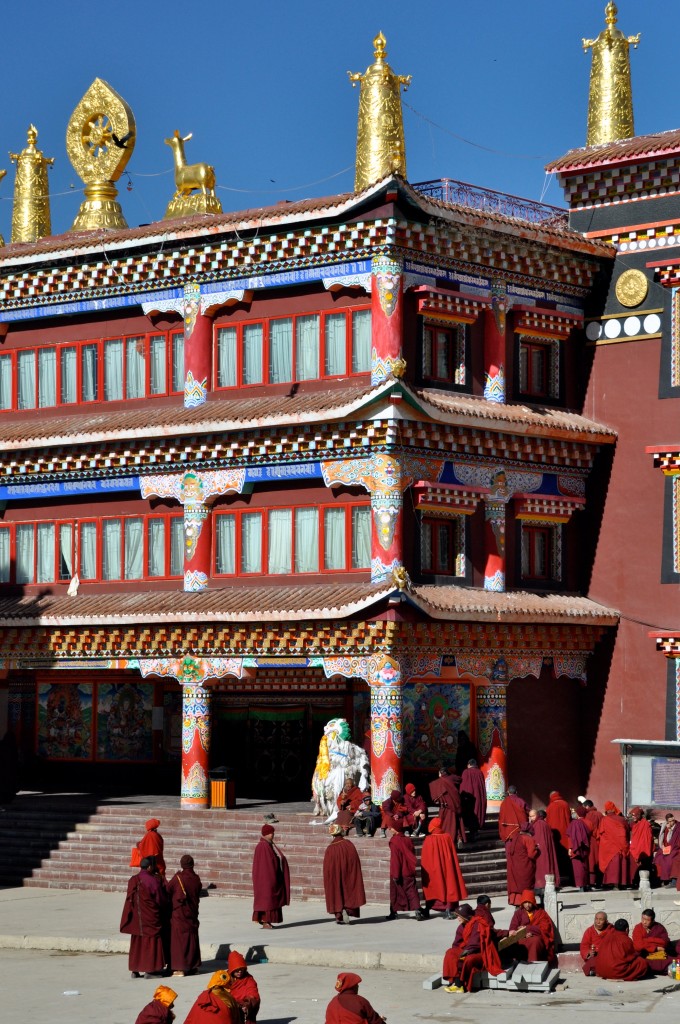
Monks standing outside the main temple at Larung Gar
Day 9: Sertar to Ganzi Distance: 150 kilometers Elevation: 3380 meters
From Sertar, it is best to return to Ganzi and continue on from there along the route to Yushu. There should be a daily bus from Sertar to Ganzi as well as a shared mini-van taxi or two.
Day 10: Ganzi to Manigango Distance: 95 kilometers Elevation: 3875 meters
The 95 kilometers from Ganzi to Manigango is along a newly paved road that goes through several small, scenic villages. From Ganzi, you leave the farming valleys behind and begin going through nomadic grasslands that are full of yaks. Manigango is a small town that is full of nomad culture. It is common to see nomad Tibetans riding into town on their horses. Whenever I am in Manigango, I stay and eat at the Manigango Pani Hotel, which is located right in the center of town. It is pretty basic, but is not bad.
Just 13 kilometers west of Manigango is the gorgeous lake of Yilhun Lha Tso, elevation 4025 meters.. This is probably my favorite lake in all of Tibet. It is so tranquil with stunning views of the surrounding Cho La Mountains. I have camped at this lake several times over the years and have always had an amazing time. If you are in Manigango, you absolutely MUST go to the lake. You can hire a taxi or motorcycle in Manigango to take you to the lake for a minimal charge. To get to Manigango, you can take the bus from Ganzi to Dege and get off in Manigango.
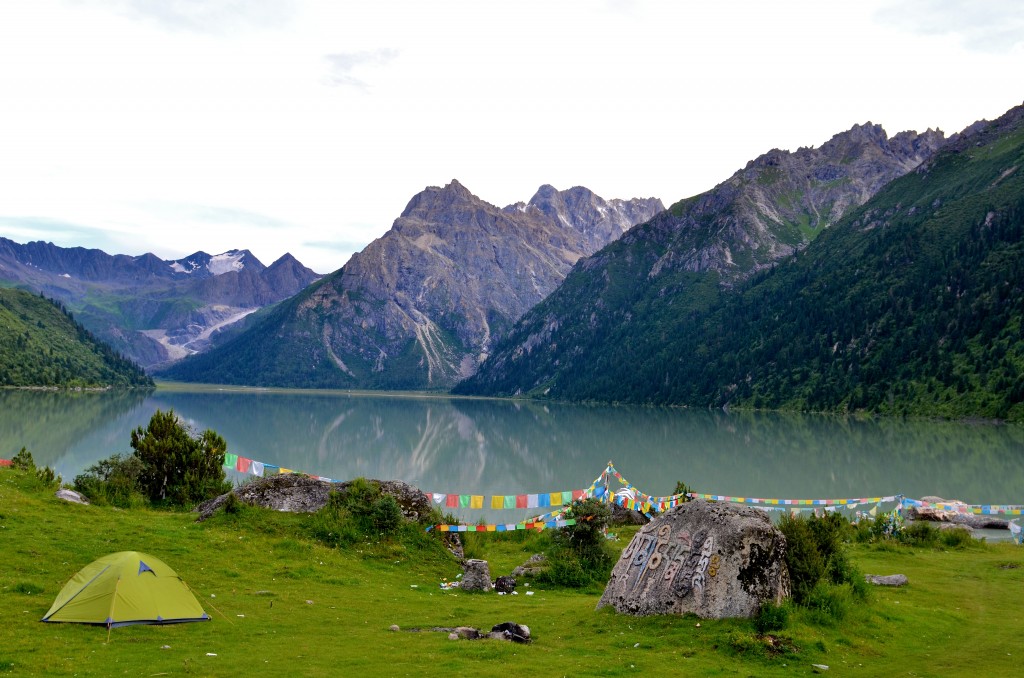
My camping spot at Yilhun Lha Tso during the summer of 2013. This lake offers amazing camping as well as great hiking opportunities.
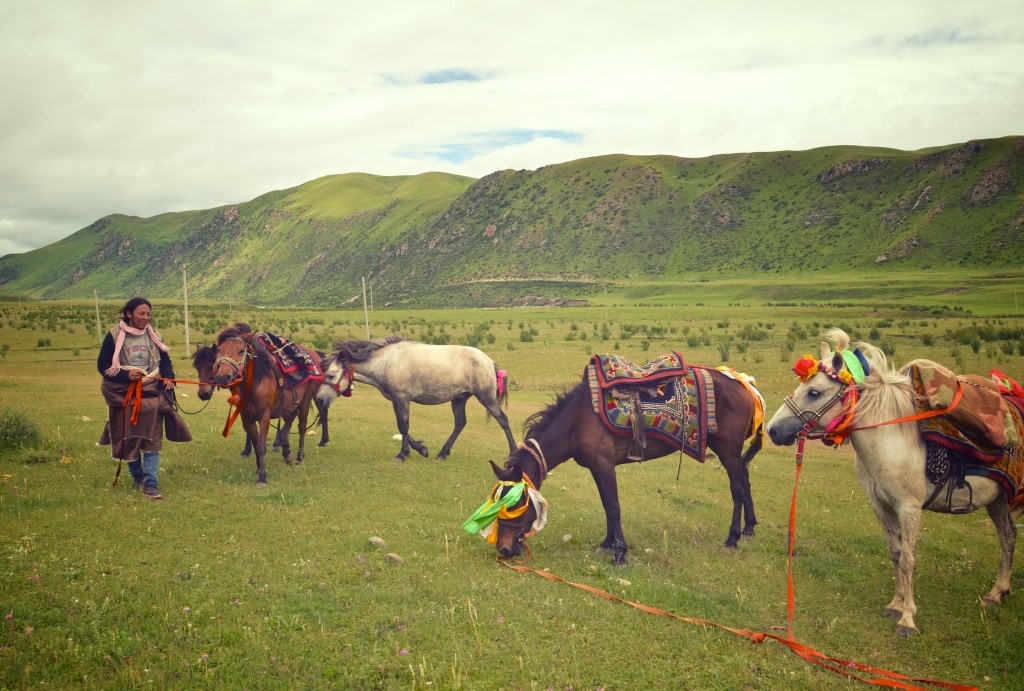
Nomad Tibetan man with his horses on the grasslands just outside of Manigango.
Day 11: Manigango to Dege (Derge) Distance: 112 kilometers Elevation: 3265 meters
The road from Manigango to Dege is absolutely terrible. A tunnel is being built that will drastically reduce the time it takes to get to Dege, however, the tunnel probably won’t be completed until sometime in 2015. Despite the poor road condition, Dege is well worth going to. Along the way to Dege, you will cross over the massive 5050 meter Chola Pass. If the skies are clear, you will get an amazing view of the snow-capped mountain range. Dege is considered to be the cultural heart of the Kham region of Tibet. It is home to the Parkhang Printing Press. The printing press was built in the early 18th century and houses over 70% of Tibet’s literary library. Buddhist scripture books are made here using traditional wooden blocks. It is quite fascinating watching the printers, who work in pairs, work as fast as they can to print the scriptures onto paper.
Also in town is the nearly 1000 year old Gonchen Monastery, which is worth exploring. Just walking through the streets in town is also a lot of fun. There are a few decent hotel options to choose from. I normally stay at either the Golden Yak Hotel or at the Hexie Hotel, both offer well priced double rooms with private bathrooms. From Manigango, you can take the bus going to Dege that originates in Ganzi. Wait for the bus in front of the Pani Hotel.
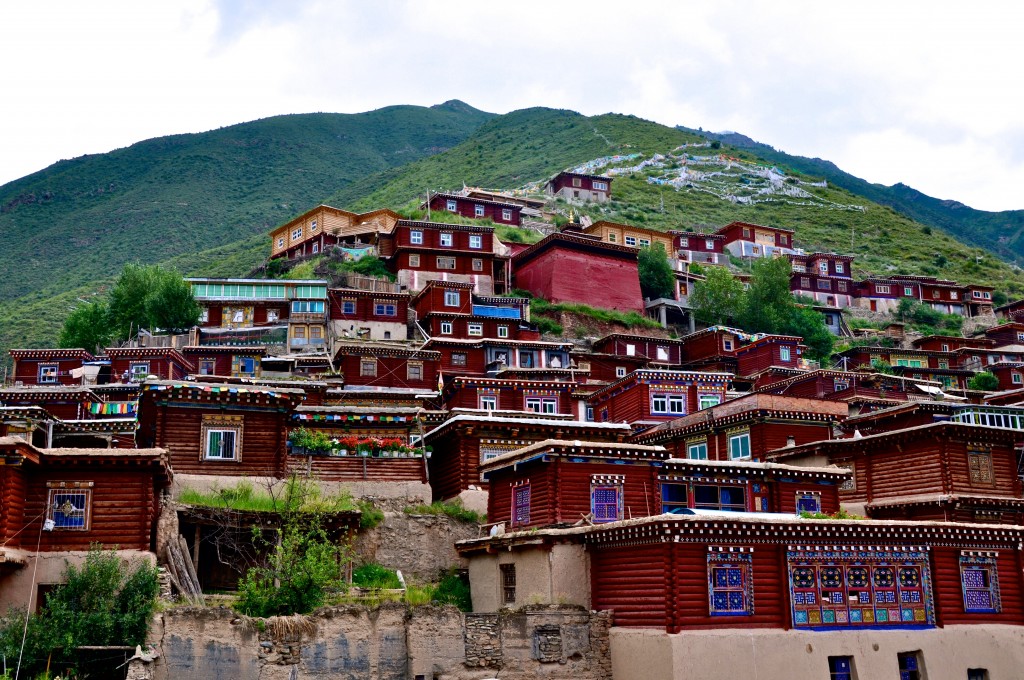
The unique wood architecture in Dege
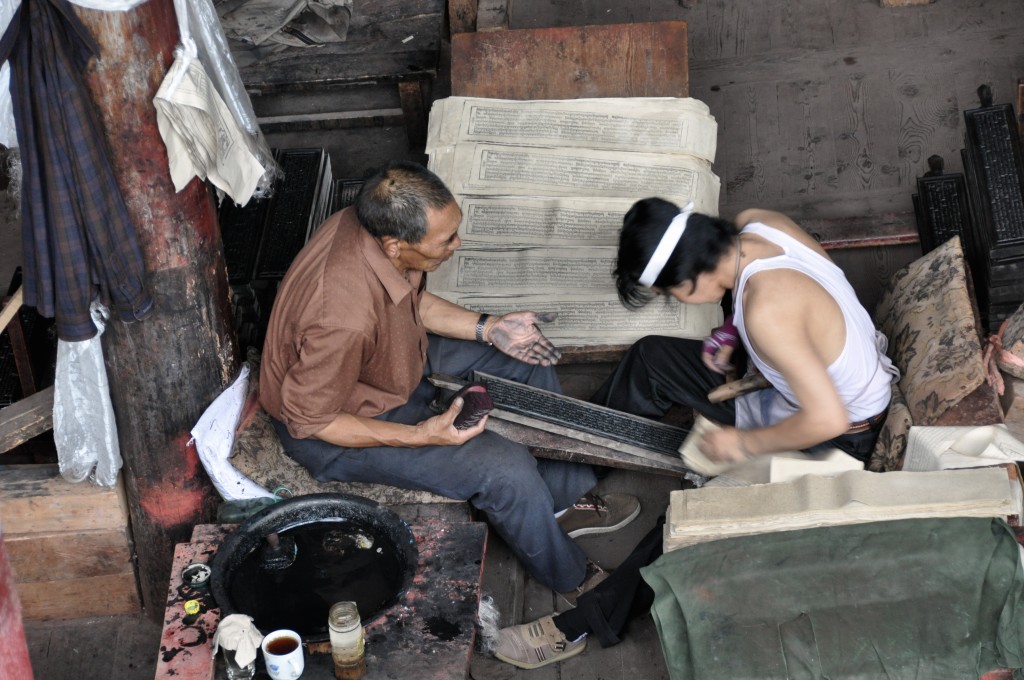
Tibetans working at the Parkhang Printing Press in Dege
Day 12: Dege to Manigango Distance: 112 kilometers Elevation: 3875 meters
Getting back on the main road to Yushu from Dege is a bit tricky. One option is to take a shared mini-van taxi from Dege to Sershul (Shiqu). In Dege, there are mini-van taxi’s that go all over the region, including all the way to Jyekundo (Yushu). However, the signs on the taxi’s are usually only written in Tibetan so be sure to ask the drivers where they are going. Another option is to take the bus back to Manigango and then take the bus the next morning on to Sershul. Of course, those with a private driver can go directly from Dege to Sershul without any problems.
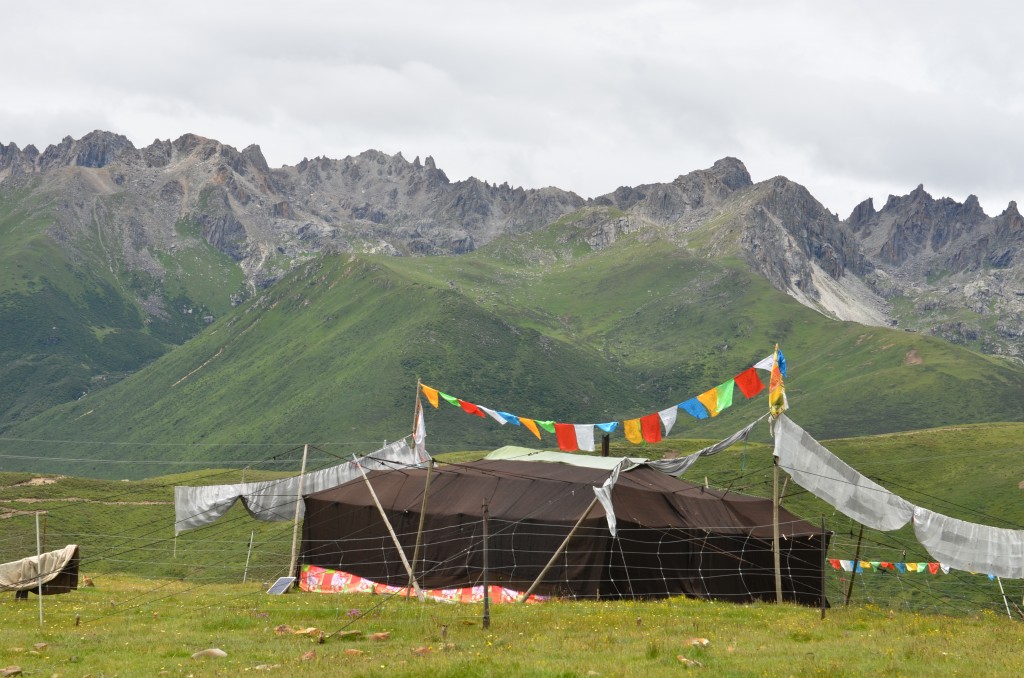
Traditional nomad tent along the way from Manigango to Sershul
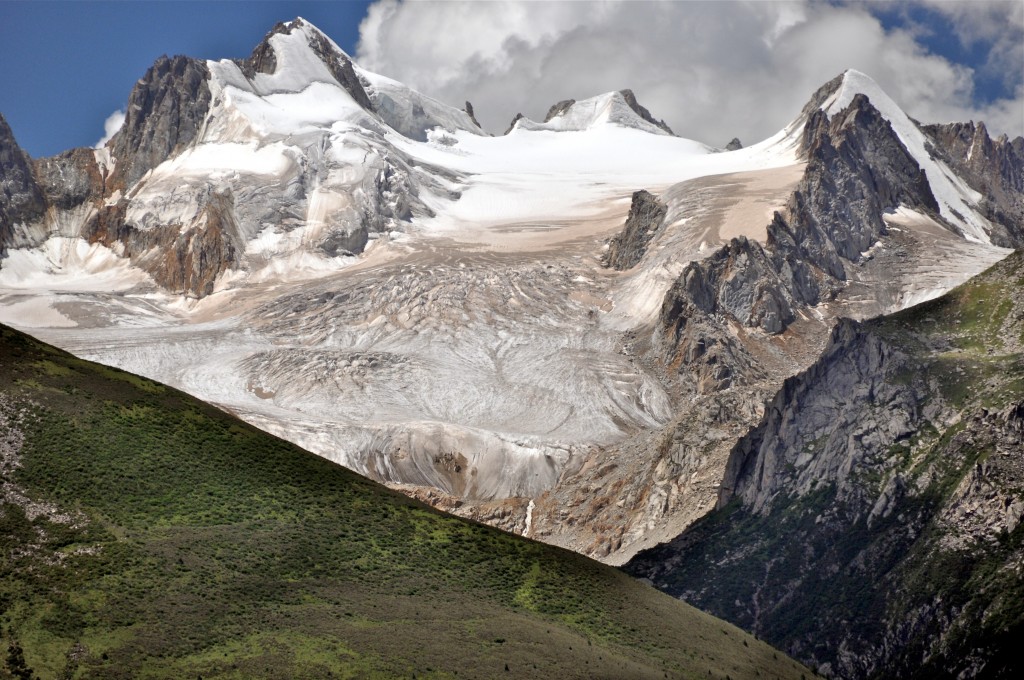
Snow-capped peak near Dzogchen Monastery along the way from Manigango to Sershul
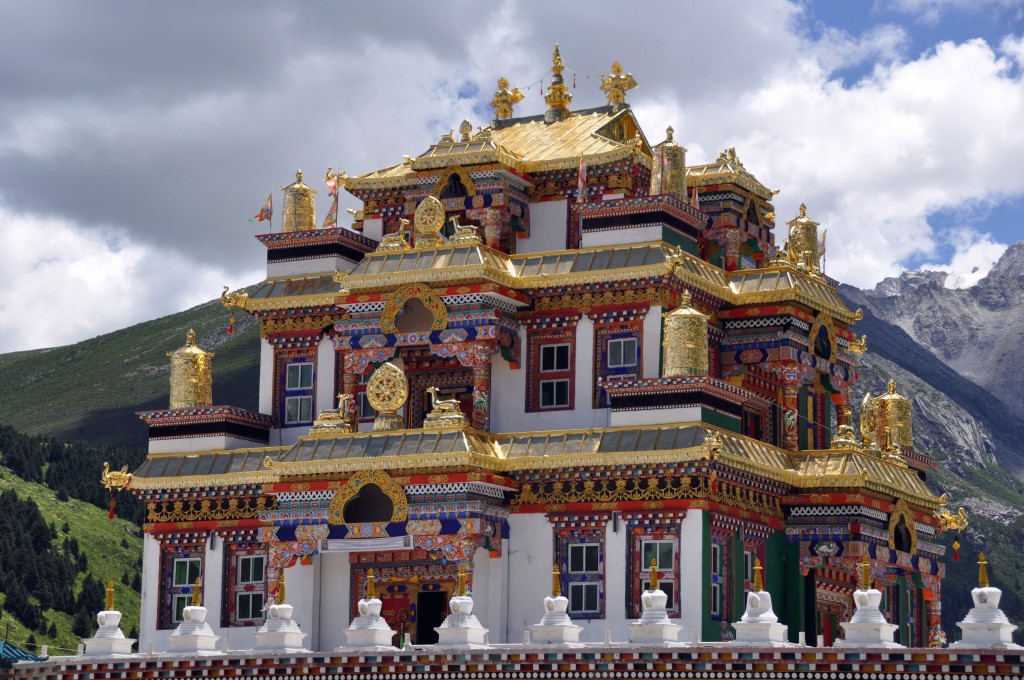
Dzogchen Monastery
Day 13: Manigango to Sershul (Shiqu) Distance: 220 kilometers Elevation: 4190 meters
From Manigango north to Sershul (Shiqu) the road is very bad and slow going. This section of road is scheduled to be repaired in 2014. To get to Sershul from Manigango, go to the far east end of town at the intersection that leads north. Wait here for the bus coming from Ganzi that is going to Sershul.
Around 50 kilometers north of Manigango is the large monastery of Dzogchen, elevation 3875 meters. If you have a private vehicle, it is well worth staying a few hours here or even staying the night. The monastery has a clean guesthouse to stay at. Dzogchen sits beneath a huge glacier covered mountain that rises to nearly 6000 meters. There is excellent hiking in the region and the monks here are very friendly.
Most of the route between Manigango and Sershul is along high altitude grasslands that are filled with yaks. There are only a few small villages along the way. Sershul is not a very interesting town, however, 30 kilometers past town is the large Sershul Monastery. This monastery is quite famous and Tibetan pilgrims and worshippers can be seen walking the pilgrimage circuit around the monastery each morning. Sershul is well-known for having terrible hotels. Last year when I was there, it took me nearly 2 hours to find a decent hotel to stay at. I can’t remember the name of it, but there is a new hotel on the far south end of town. As you are coming from Manigango, the hotel is on the right side. Sershul Monastery also has a small, but clean guesthouse with a nearby restaurant.
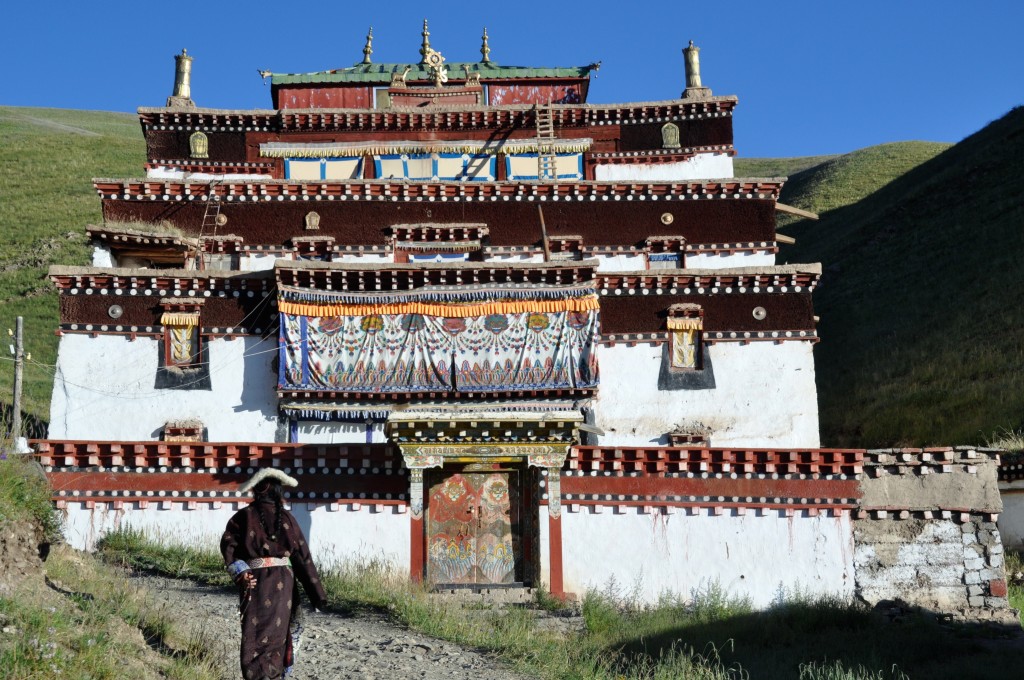
Tibetan woman walking around Sershul Monastery
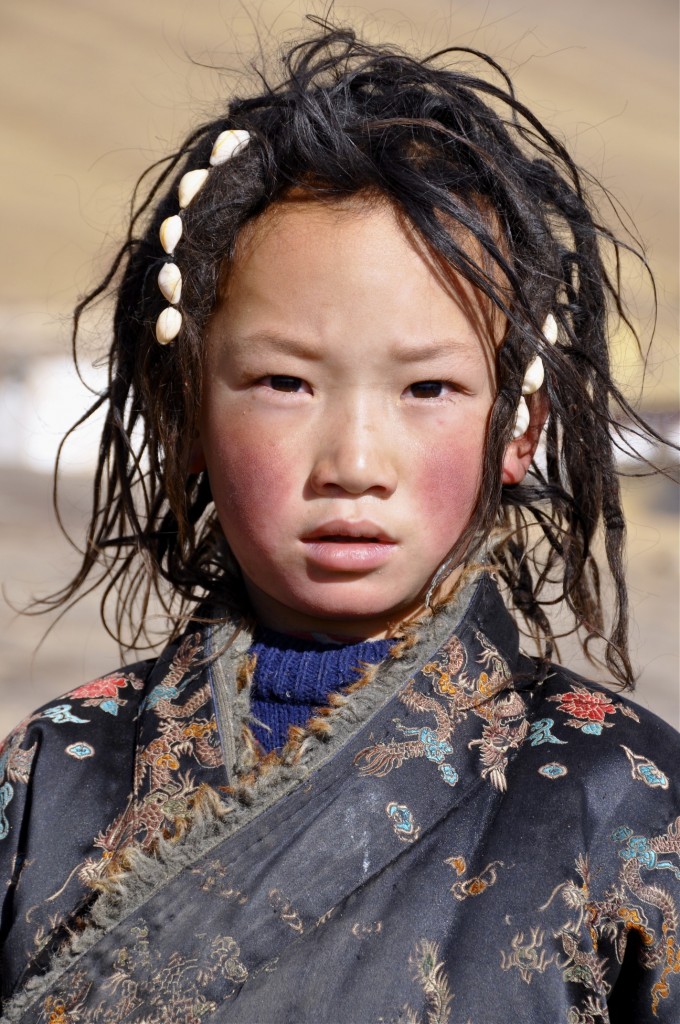
A young nomad girl at Sershul Monastery
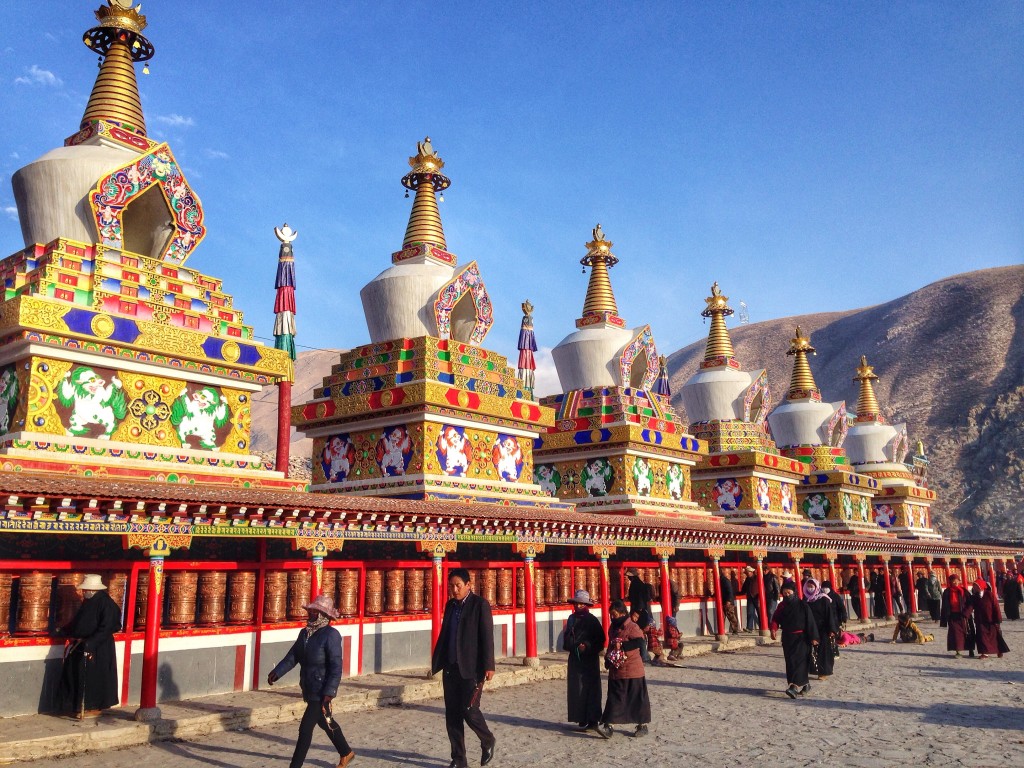
Pilgrims walking around the Gyanak Mani Temple just outside of Yushu (Jyekundo)
Day 14: Sershul To Yushu (Jyekundo) Distance: 145 kilometers Elevation: 3700 meters
On April 14, 2010, a devastating 7.1 magnitude earthquake hit Yushu prefecture destroying the prefecture capital of Jyekundo as well as many surrounding villages. In November 2013, the government officially announced that the region was finished being rebuilt. Jyekundo, which was upgraded to city status, is rebuilt in a kind of modern Tibetan design. It is drastically different than the way Jyekundo looked before, however, the new town is pleasant and worth spending a couple of days exploring. Of course, the areas outside of Jyekundo that are within Yushu prefecture are quite stunning. For more information on Yushu prefecture, go to the following link: Yushu Tibet Autonomous Prefecture.
There is a daily bus from Sershul to Jyekundo and there should be a couple of shared mini-van taxi’s covering this route as well. From Jyekundo, there are multiple daily buses going to Xining as well as 1 or 2 flights per day.
The above route is ideal if you have a lot of time to really see the region. When I travel or lead photography tours, I usually travel slowly in order to really see all that the region has to offer. I understand that not all travelers have lots of time. If your time is less, you can do this overland route quicker. In fact, you can probably do it in two days. There is a daily bus from Kangding to Ganzi (Garze) and there should be a daily bus from Ganzi directly to Yushu (Jyekundo). However, taking these buses won’t allow you to really see anything that this amazing route has to offer.
I always recommend people to travel by private vehicle if they can afford it. Yes, I know the cost of the private vehicle is quite high, but the private vehicle will allow you to stop at all of the awesome monasteries, villages and nomad communities that are found between towns. Most of the best places to explore are found between towns that the public bus just speeds by. If you are interested in traveling this route by private vehicle, please contact me at thelandofsnows@gmail.com and I can give you some travel agency and tour guide recommendations.
If you travel the overland route from Kangding to Yushu, taking detours to Sertar and Dege, the total distance is around 1375 kilometers. If you stay on the main highway without making detours, the distance is about 850 kilometers. If you have any questions about this route, feel free to contact me.
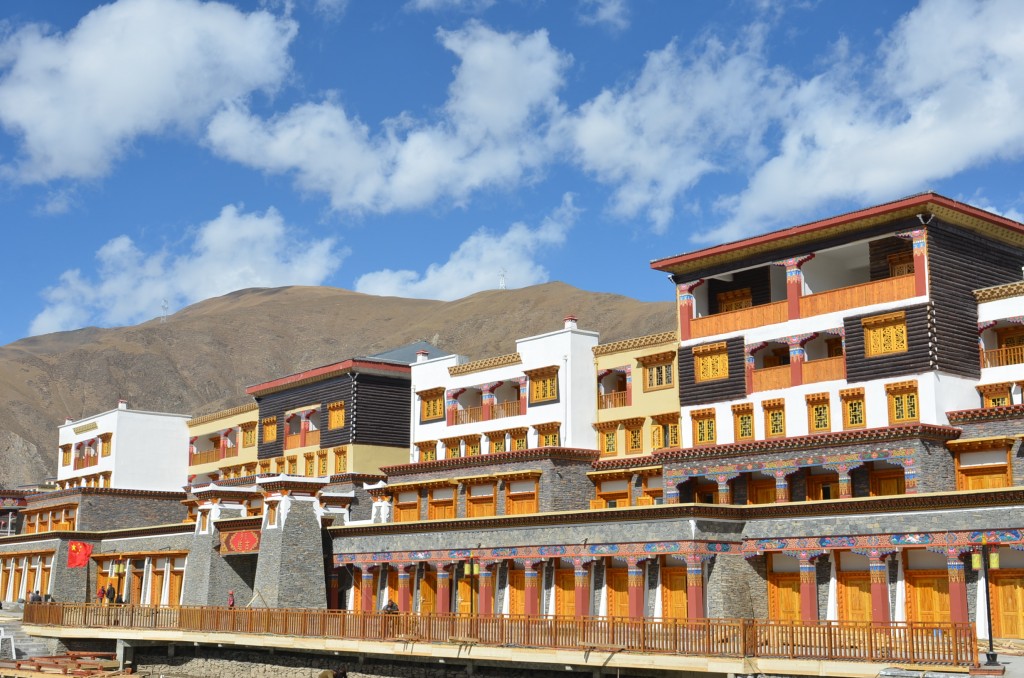
Newly built shops along the river in Jyekundo
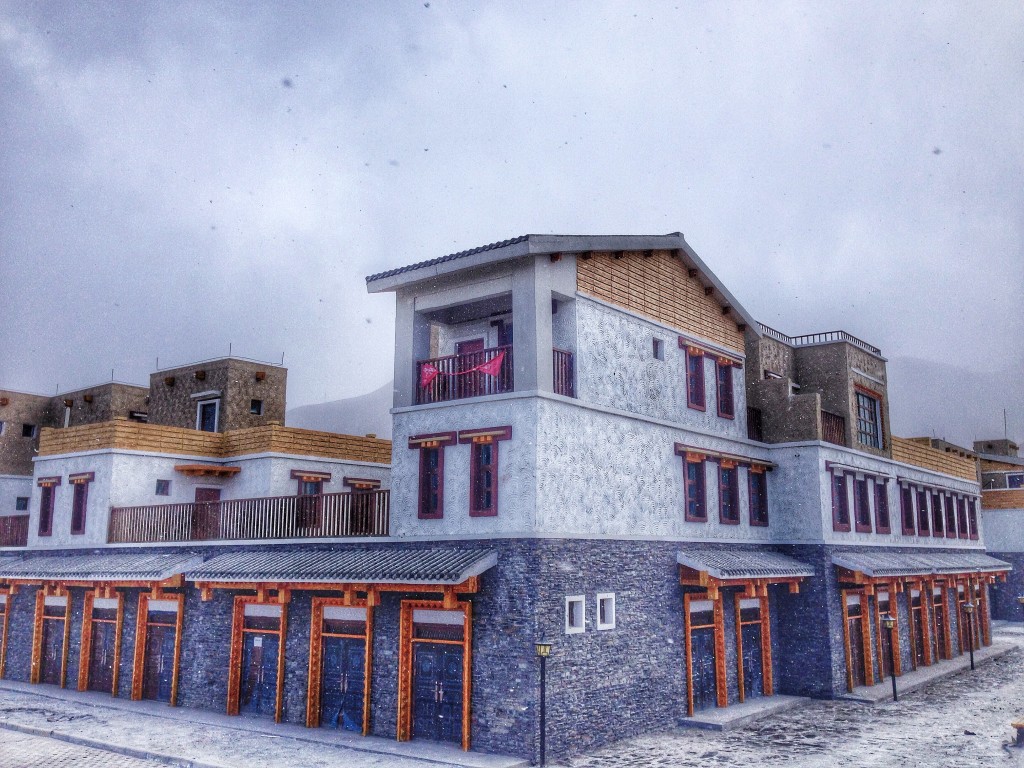
Modern style homes and shops in the rebuilt Jyekundo
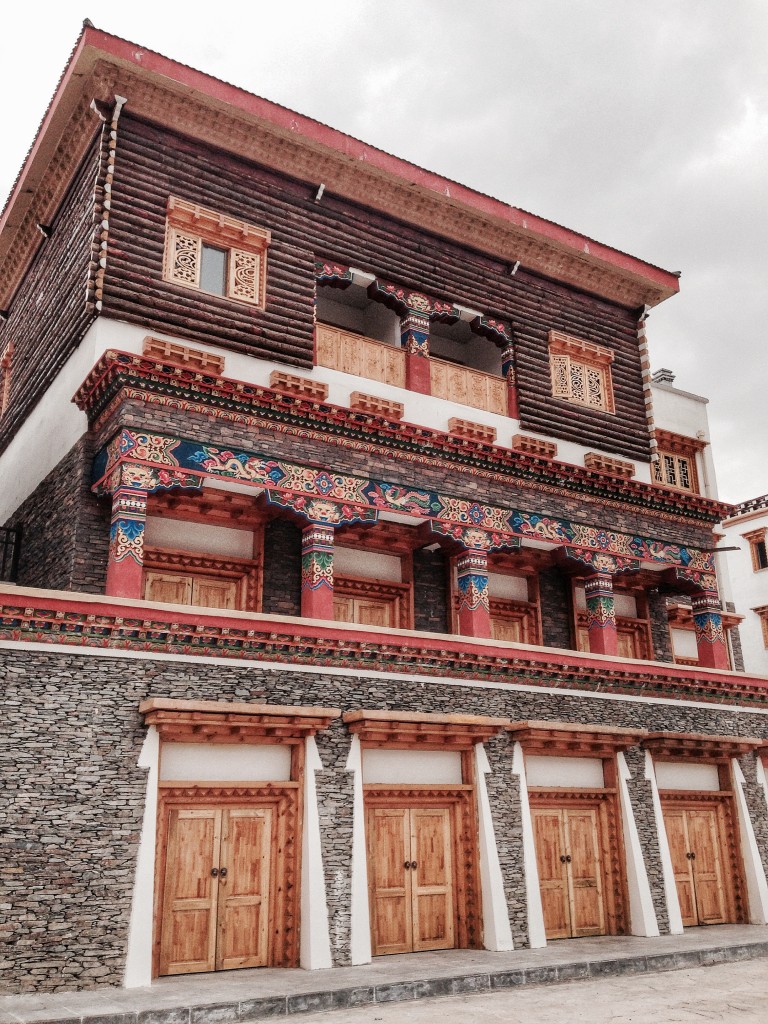
Buildings in the new Jyekundo

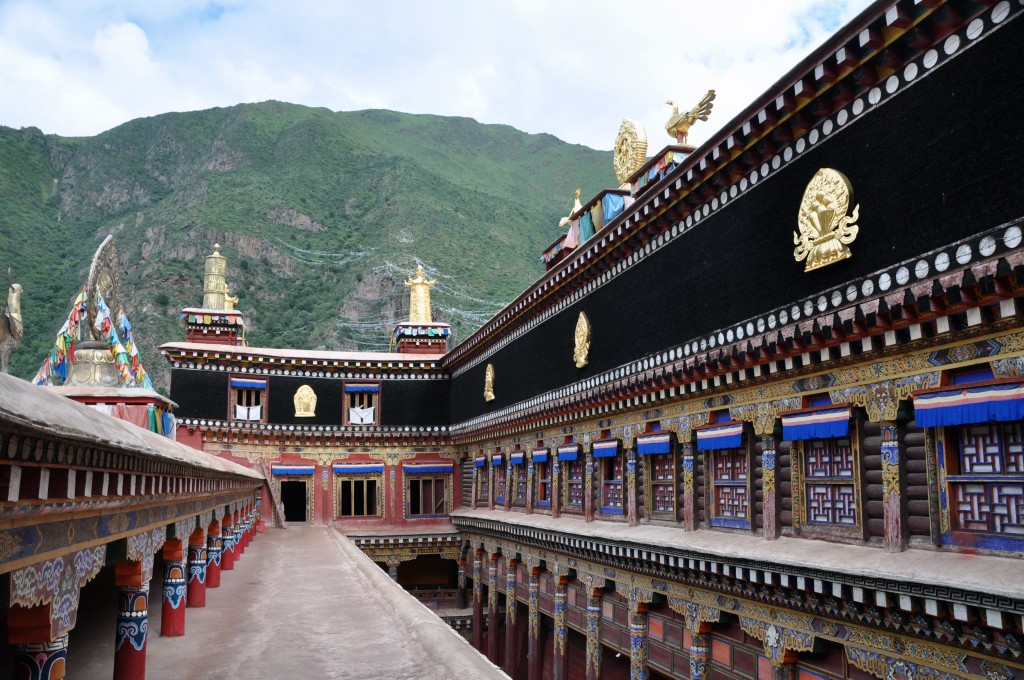
Absolutely gorgeous pictures, and wonderful descriptions of the trip. I’m putting Tibet on the top of my travel to-do list. Thank you!
This is just the sort of tour that I would like to do in Tibet, scenery plus culture, (especially Larung Gar)plus learning about the traditional nomadic life. Thank you for sharing the route.
Do you know of a travel agency that is doing this exact tour?
If not then my husband and I would like to do it in a private vehicle with a guide.
Your suggestions for Tibetan owned and operated agencies and guides would be appreciated.
Thank you
Judy
having travelled to tibet many years ago,i would like to go back and do this trip,your pictures are amazing and the scenery stunning,thankyou for this.
Hi, Thank you for your wonderfully informative blog. It offers a detailed and extensive peek into fascinating Tibet. I am an Indian national. I have already been on the Kailas-Manasarovar trek years ago and in June 2014, went to Lhasa and from there, took a train to Chengdu. There are many restrictions on Indian citizens travelling in TAR.
Would love to do the Kangding to Yushu overland trip in 2015, preferably in a hired vehicle. I can get four or five more Indians to join me on this trip. Could you please recommend an agency which can organize this for an Indian group? Language seems to be our main problem in navigating Chinese regions.
Amazing beauty. Beautiful photos. Inspiring. Thank you!
Pingback: My favorite towns across the Himalaya | The Land of Snows
The pictures are amazing. Thank you so much for your introduction to MysticTibet Tours
Gonkho is a knowledgable, caring man and we are delighted to have met him and look forward to out trip to Yunnan and Tibet
You are very welcome! Enjoy your journey!
Losang
i am in yushu now. i want to go to kangding. what do you suggest and how should i get there? do i need to have any permit to go there as it is part of tibet autonomous region?
your response will be highly appreciated.
Yushu is located in Qinghai, not the Tibet Autonomous Region. In addition, Kangding is located in Sichuan, not the Tibet Autonomous Region. As you will be traveling in Qinghai and Sichuan, NO TRAVEL PERMITS OR ORGANIZED TOUR IS NEEDED. This is a great route and I am sure you will love it!
Lobsang
Hi, I just did this trip with my Girlfriend and it was really amazing trip (including Dege, skiping Sertar).
We rely totally on public transport which means we mostly traveled by shared minivan.
A lot of the roads got developed but not all, in generall as more you get north as more bad get the roads Anyway, we didnt had any problems with the roads just a little bumpy and it take a while
.
If someone interested doing this trip maybe following information (July 2015) might be helpful:
Chengdu – Kangding: 162 CNY for 9 am bus (have toilet on board); Mrs Panda Hostel in
Chengdu can arrange tickets for CNY 20 per Ticket
Kangding to Tagong: Shared minivvan (car) for 50 CNY p.P., around 9 am ; Zhilam hostel is awesome, hike on backside as well; they can tell you where car starts
Tagong
Tagong: Khampa cafe / hostel is now owned by the funny Czech dude called Max
Tagong to Garze: Shared minivan CNY 130 p.P (somehow no bus stopped; we changed car 3 times and at one spot we wait 1 hour to find more ppl)
Garze: Himlaya hotel: Room was not the cleanest and lightswitch outside of hotel room; next time we try different hotel; Garze is very dusty!
Garze to Dorjay Monastery: 80 CNY / taxi, awesome place
Dorjay Monastery to Yilhun Lha Tso – 300 CNY for private car incl pit stop at manigango (Yilhun Lha tso is nice but please bring mosquito repellent; it was crazy! Finally slept in Manigango)
Manigango to Dege: 100 p P fir shared minivan, most of road is paved but tunnel not ready yet so taking spectacular Cho la pass on dirt road (worth to go if you are not adfraid of height)
Dege: Golden Yak hotel so dirty and disgusting that we didnt check in there (i think it was nice long time ago and no it is given up); instead stayed at Dege Hotel, for 190 basic room and for 380 really nice room with luxury bathroom); the city center is dusty and ugly but it is worth to climb up to the old part)
Dege to Sershul Monastry: 170 CNY pP in shared minivan (starts at 7am, we arranged evening before and they picked us up at hotel), road most parts not paved and it takes long, also including a nice pass but not as spectacular as Cho la pass
Sershul we stay at Guesthouse right hand side of monastry, 50 pP, clean 3 bed room but there are no toilets or showers). Monastry worth seeing it and walk up the hill also very nice, with monk houses, we see some mass going on
Sershul monastry to Yushu: 50CNY p P in shared minivan, around 10 am but took long to get car full
Yushu: We went at the time of hourse festival so many hotels where full, finally we find a very basic one for 198 for 2 person with bathroom.
Princess temple, especially the kora on the mountain around is really worth seeing it.
Horse festival was 50% carnival so it feels a bit commercial so a bit disappointing.
Flight from Yushu back to Chengdu is spectacular, you can see some places you visit before…
Finally, I have to say our favorite places was Tagong and Dorjay Monastery where we also did camping.
I forget to mention following:
Excluding Kangding and Yushu itself, the internet is totally shut down in the whole area (Tagong, Garze, Manigango, Dege, Sershul) in the moment (locals say because of 80th bday of Dalai Lama).
Thank you for the valuable information . I decided to make the trip from Kangding to yushu just reading this site .
I planned to take this route in August, but I’m worried about the weather . I can not figure out if it rains every day , or if the only problem is the cloudy sky .
thank’s
Angelo
There will be rain, but it will not be everyday. Enjoy your journey through the Kham region.
Lobsang
Hello Lobsang and everybody!
Just now I am writing from Ganzi. We follow this route from Kangding to Yushu and tomorrow we will proceed to Manigango and Yilhun Lha Tso.
Here I share our experience about the latest conditions of the route from Kangding to Ganzi:
From Kangding to Tagong the road is good, but the first part of it- from Kangding to Zheduo pass, it is road 318, to Lhasa, and the traffic there is very heavy. We drive our own rent car, and there are many slow trucks on the road, which make many problems on the road. But after Zheduo pass, there is a good road beside the Kangding airport, without trucks, with great views on the grassland. But seems it is only for private cars and minivans, the bus to Tagong doesn’t pass there.
The next day we went from Tagong to Garze (Ganzi). The road pass through very beautiful places, many villages with new and beautiful houses in Tibetan style. But currently the section from Tagong to Bamei is under construction, and it is difficult to drive there, also it is very dusty. But after Bamei the road is perfect. Only in Dawu town we had to leave the main road and drive on a new road on the west side of the town. Then when we arrived to Road 317, we proceed the last 92 km to it. Road 317 is perfect too.
About Ganzi- I can say that the town is nice, but currently many streets in it are under construction, and all the town is very dusty. Only the south part of the town is new and clean.
For those who rent a car or hire minivan taxi or something like this I can also recommend the road to Baiyu (白玉县). There are splendid beautiful snowy mountains south of Ganzi. And the road to Baiyu (Ganbai road) enters through these mountains. So we drove about 25 km on this road- to the mountain pass in Mt Zhuoda (I am not sure, but we asked a local Tibetan and he said this is the name of this mountain) at 4755 m altitude. The road is perfect, newly paved, until about 4300 m, then it is planned to pass through a tunnel under the mountain, but the tunnel is still under construction, so we proceed on the old road, which is dirt road from this point on. The views around this road are really breathtaking!
Tomorrow we plan to proceed to Yilhun Lha Tso, and I would be glad to share our experience when we find some internet.
Hello again!
In my previous comment I shared my trip from Kangding to Garze, now let me share my experience just few days ago, from Garze (Ganzi) to Yushu.
On the next day we went to Manigango and Yilhun Lha Tso lake. Manigango is a very nice and clean place. The road from Garze to Manigango is perfect. Then we went to Yilhun Lha Tso, and decided to camp there. The entrance fee is 30 RMB, and if you want to camp there for one night- pay more 15 RMB. We walked on the east coast of the lake- there is a small path, which dissapears sometimes, then appears again, and it makes the walk on the coast difficult, but the view to Chola mountain and the lake is really breathtaking. There is a grassland south of the lake, under the glacier of Chola mountain and the waterfall below it.
About the mosquitos- don’t be afraid of them! They were very active at daytime, but about 20:30 at evening they disappeared, because it became cold. So we slept nice, without any mosquito problem.
The next day we proceed to Sershul, and stopped at Dzogchen monastery. The road from Manigango to Sershul is new paved and excelent, with exception of a mountain pass between Manigango and Dzogchen village, where the road is going to pass through a tunnel, but it is still under construction, so we had to drive on the old terrible road- fortunatelly only about 15 km.
Dzogchen monastery is big and interesting, there was a celebration there, when we passed it. The village below it is very dusty.
Sershul is a nice town. We slept in a very good hotel, just in the beginning of the town, on the right side of the road. Then the next day we visited Sershul monastery, and saw the lamas and the kids students, they invited us even to enter in their classroom, to see their lesson, it was very nice.
The road from Sershul to Yushu is perfect until the mountain pass at the border between Sichuan and Qinghai. Then in Qinghai is not perfect, but still very good.
Yushu is a very nice city now. And we have a dinner in a good restaurant in traditional Tibetan style- the restaurant is just at the east coast of Batang river, in a small modern complex, right in front of the king Gesar monument square. I don’t know its name, but on its door is written “Grandma’s kitchen”.
The next day we proceed to Amnye Machen and Qinghai lake. I will share about Amnye Machen when we finish our trip, in Amnye Machen web page.
I would love to do this trip one day, what is the best time of year to do it? Thanks everyone for the extra input, it looks amazing. I will wait for Larung Gar to open again thou.
Good times of year are late April through early June and then again from late September through mid/late November.
Lobsang
Dear Sir hello,
Would you know if the road from Garze to Yushu is usually open in December, or are snowfall and road closure a high probability ?
Thank you for your enthousiatic, accurate and very usefull descriptions of thoseTibetan areas.
All the best to you and your familly for 2017
Dede
Dede….the road is open all year long. There is always a chance of snow in the winter months, but it is rare for the road to be closed for long periods of time. The route from Garze to Jyekundo (Yushu) is spectacular! Have a great journey!
Lobsang
Hello, Your website is fantastic.
I am planing to go overland from Xining to Yushu and then from there to Litang and to Shangri La.
I need some permit for go theses areas? Also may be make in the another way, starting from Shangri La to Xining, I must go to Kanding from Litang to reach Yushu?
I am planing to make from middle of May to middle of june, is good season?
Only the Tibet Autonomous Region (TAR) requires an organized tour. The places you are going to are NOT in the TAR, but are in Sichuan and Qinghai provinces. You can visit these areas on your own, without permits or an organized tour.
Lobsang
Hi Lobsang, i enquired many years ago to travel this route and into TAR, but due to births and what not it had to be put off. now i am ready with my friends.
we plan to buy motorbikes in Kangding and self ride to yushu, I understand we can not travel the the Chamdo prefecture, how would it be possible to travel to reach Nagqu and then onwards to ebc via lhasa or any routes you would recommend. i understand that once we enter the TAR we will need a guide, is there any recommendations for a good budget motorcycle guide/agency you could give and where would be a good initial point of entry into the TAR from Yushu?
look forward to hearing back
thanks
Ben
Hi Ben….you cannot enter the TAR from Yushu prefecture as the prefecture in the TAR that borders Yushu is Chamdo. Chamdo remains closed to foreign travelers. You will need to enter the TAR from the Golmud-Lhasa Highway. Motorcycle tours in Tibet are NOT for budget travelers…..not even close. Even a short motorcycle tour will cost thousands of USD. You need far more than just a guide! You will need a private vehicle, MANY permits, a driver, an official itinerary as well as a guide. I have emailed you further info to help you.
Lobsang
Any idea what Larung Gar is like these days? Is it still possible to visit, and is it still as spectacular to see as it was perhaps a couple years ago before any reduction to housing?
Still closed….likely will be for a long time to come.
Lobsang
Hi.Thank you so kuch for all this baluable info!I was wondering if you can aleo recommend some place to stay in Yushu?
I wanted to thank the author of this post. I have just completed this journey. I did it solo by motorcycle. Quite an experience. Without this blog, I’d not have had the inspiration our relevant information to do the trip, so much heartfelt thanks.
You are very welcome! I am glad my advice was helpful!
Lobsang
I am considering doing this trip in late December rock early January of this year. My time framework is slightly shorter than the trip you have outlined here – closer to 12 days. Do you think the cold will be so intense that it won’t be worth it?
This route can be traveled all year long. It is a great route! I suggest going slowly in order to really experience it.
Lobsang
Hi Lobsang, thank you so much for very helpful site. This trip will be journey of my dreams for next year, most probably October together with my girlfriend. However we are little bit afraid of language because we did not speak chinese or tibetan. Do you think that it is possible to move in Sichuan part of Kham by public transport without chinese/tibetan language? We have some similar experience from North Vietnam tribes with google translator and drawing of pictures 🙂 Thank you.
I just finished this trip (with a few variations) and had an incredible time!
I was lucky enough to get to visit GonGa Shan, five hours from KangDing. Besides that, though, Ganzi was definitely my favorite stop. We stayed with an American named Nate who runs a hostel with delicious western food and comfortable beds. There were lots of great hikes around, and the monastery in Ganzi old town was one of my favorites.
Getting between places was also much easier than I expected, though I speak a little Chinese and we were traveling during the off-season, which probably helped. We used shared mini-buses basically the whole way, which was very convenient, if sometimes a bit uncomfortable. The drivers seem to make a sport out of seeing how many people they can get in a car.
Anyways, amazing trip! Thank you for the itinerary.
Please suggest a tour operator who can build us a itinerary like this, and handle Indian/Irish passports.
Thank you for your wonderful post! I have been researching and saving to make my dream trip to Tibet for so long!
Hi, I have emailed you further info to help you travel this awesome route!
Lobsang
Thank you for all the great info on this site. A few years back, i followed many of the advice/tips here when planning my trip crossing from Yunnan to Sichuan; it was definitely one of the highlights from my travels. This year I’m hoping to make the route from Chengdu to Yushu. I just found out my travel time will coincide with the Yushu horse festival. Do you know where exactly is the horse festival held?
And from Derge I wonder if I can make a detour to Yarchen Ga. Do you know what kind of transport is available? Most info I’ve found only discusses transport to and from Garze.
Many thanks!
Starting in May 2019, Yarchen Gar is closed to foreign travelers.
Lobsang
Hi Lobsang, I am Dutch and 73 years. I am sure I never will visit Tibetan region in this life. But your pictures and writings let me nearly touch the grond.
I have a question: yesterday here in My place I was in a small shop. The owner is a Tibetan young man, his family all over the world. He tries to make a living with selling Tibetan products. On instagram you will find the shop #kostbaartibet.
I will help him for free by designing a good website for the shop. Now my question: will you allow me to use some picturers and maybe some of your writings for this website?
Maybe it is a nice promotion for your work too: Dutch people are very interested in Tibet and traveling over there.
Love to hear from you and all good blessings.
Hans van Zanten